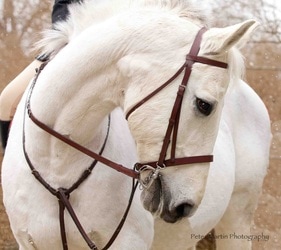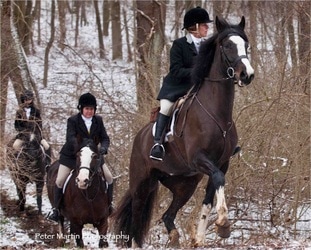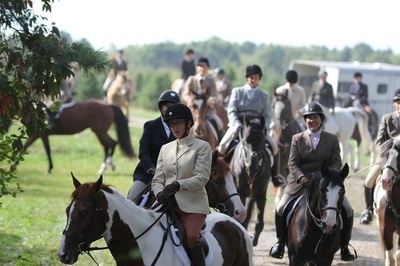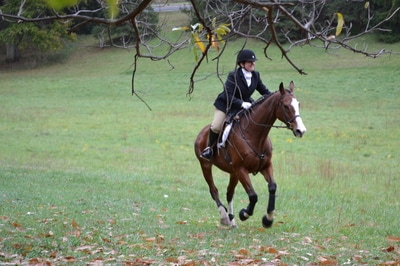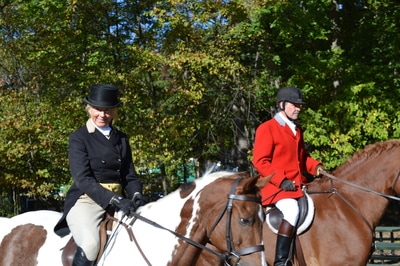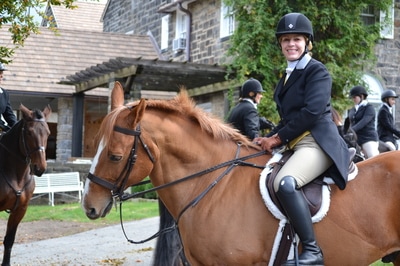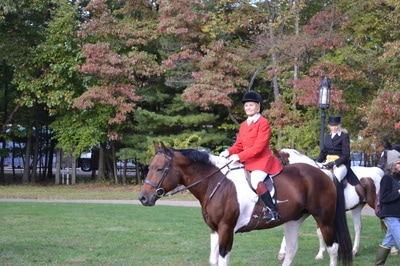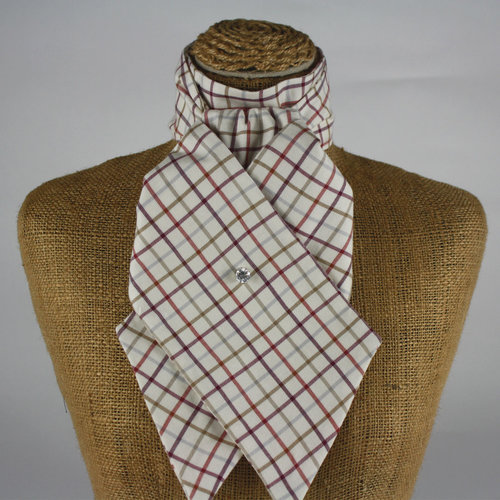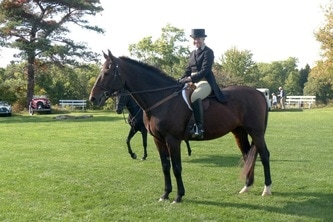
Masters, officers, and staff endeavor to honor both the traditions of the sport and the practical considerations that help promote a safe and enjoyable day in the hunt field. While attire is important to maintaining the history and tradition of our sport, the foremost reason for rules regarding attire are that of safety for the horse and rider.
It is only through the graciousness of the landowners over whose property we ride that we are able to engage in this sport. A properly turned-out field honors the landowners, shows them we take our sport seriously, and displays the appropriate spirit of tradition as they watch us ride by. The preservation of the centuries-old fox hunting spirit depends, more than anything else, on the continued observance of the rules of etiquette that distinguish this activity from simply riding casually around through the countryside. Besides the landowners, we also depend on masters and huntsman for the enjoyment derived from a long season of hunting. The leaders of the hunt work hard to provide members the opportunities to follow hounds and nothing cheers the heart of a huntsman or master more than to gaze upon a well turned-out field of riders who conduct themselves properly. This demonstrates the members’ recognition of their efforts on behalf of the field, especially the huntsman who devotes long, hard days of work to give members a few hours of sport.
Considerations on proper turnout for both horse and rider are detailed below. Attire varies according to three main variables—gender, colors, and autumn hunting versus formal season.
It is only through the graciousness of the landowners over whose property we ride that we are able to engage in this sport. A properly turned-out field honors the landowners, shows them we take our sport seriously, and displays the appropriate spirit of tradition as they watch us ride by. The preservation of the centuries-old fox hunting spirit depends, more than anything else, on the continued observance of the rules of etiquette that distinguish this activity from simply riding casually around through the countryside. Besides the landowners, we also depend on masters and huntsman for the enjoyment derived from a long season of hunting. The leaders of the hunt work hard to provide members the opportunities to follow hounds and nothing cheers the heart of a huntsman or master more than to gaze upon a well turned-out field of riders who conduct themselves properly. This demonstrates the members’ recognition of their efforts on behalf of the field, especially the huntsman who devotes long, hard days of work to give members a few hours of sport.
Considerations on proper turnout for both horse and rider are detailed below. Attire varies according to three main variables—gender, colors, and autumn hunting versus formal season.
"While attire is important to maintaining the history and tradition of our sport, the foremost reason for rules regarding attire are that of safety for the horse and rider."
Proper TackThe horse should arrive at the meet clean, neatly trimmed, and properly tacked up. Hunting tack is not fancy.
|
Autumn Hunting
During autumn hunting season in September and October, there is no distinction in attire between members who have been awarded colors and those who have not (or, for that matter, between the field, masters, and staff). There is also very little difference regarding the attire of gentlemen and lady members.
- Hacking jackets are worn by both ladies and gentlemen, preferably wool tweed or a linen material and in an earth tone color such as shades of brown or green. Subtle plaids, checks, herringbones and houndstooth patterns are correct. Jackets should have three buttons, all of which are kept buttoned during the hunt. The jacket should be tailored specifically for riding with a single vent; a conventional sports coat is not an acceptable substitute.
- Vests may be worn by men or women in tattersall or tweed. Canary or Sewickley Hunt Gray vests should be reserved for the formal season.
- Shirts and blouses should be a pastel color and muted striping or subtle patterns are allowed. Both men and women may simply wear a dress shirt and tie, either bow tie or long tie. Ladies may wear ratcatcher collars, either plain or with a stock tie. If a stock tie is worn, it should be colored and/or patterned but not a plain white or ecru formal stock. Gentlemen may also choose to wear a hunting shirt and stock tie. The ends of a stock tie should be secured to the shirt with safety pins to hold the tie in place. Gentlemen wear a 3” plain gold colored stock pin, ladies a 2 1/2” gold colored stock pin.
- Breeches may be beige, buff, khaki, rust, or canary. White breeches and dark colors, such as forest green or navy blue, are not correct.
- Brown field boots or newmarket boots with brown garters are the most appropriate footwear for autumn hunting, followed by black dress boots (without brown leather or black patent leather tops). Paddock boots with gaiters or any variation thereof are never proper in the hunt field for adult riders during either autumn hunting or formal season.
- ASTM/SEI Certified helmets should be worn in either brown, or black.
- Gloves may be shades of light or dark brown, either full leather or with crochet backs. Pigskin, deerskin and leather are used.
Formal Season
Once formal season begins more distinctions apply based on the member’s gender and whether or not he or she has been awarded colors. There are, however, four elements of proper turnout that are universal—headwear, neckwear, gloves, and vests—and we will consider these first.
- Headwear: All members of the field should wear an ASTM/SEI Certified helmet in either brown, or black. Ribbons at the back of the helmet should point up. (Masters and professional staff signify their positions by turning the ribbons to point down.)
- Neckwear: The only appropriate neckwear during formal season is a white or cream stock tie, properly tied and secured with a plain gold pin. The pin should be placed horizontally; only professional staff may place the pin vertically. Although faux stock ties are permissible, a full length, four fold stock is preferable both for the sake of appearance and, more significantly, in the event it is needed as a bandage or sling. It is also recommended that the ends of the stock tie be secured to the shirt or blouse with safety pins to assure the ends of the tie do not work out from beneath the coat and flap loosely in the wind. Again, men wear a 3” stock pin, ladies a 2 1/2” stock pin in gold.
- Gloves: Gloves worn during formal season may be brown, either dark or lighter shades such as tan or buff, full leather. White or buff string gloves or chamois gloves are suitable for rainy conditions.
- Vests: Appropriate vests are canary or tattersall (in various color combinations). A vest made from material matching the hunt’s official color of gray is also acceptable. Canary is the most formal color.
Other elements of formal turnout vary according to gender and whether or not the member has been awarded his or her colors. These distinctions run as follows:
Gentleman with Colors
Lady with Colors
|
Gentleman without Colors
"Masters signify their position by wearing four buttons and a huntsman, or a master who also hunts hounds, wears five buttons." Lady without Colors
|
"Stay at home on a bad day and you will miss some of the best hunting."
- Mrs. J.O. Burgwin, Co-Founder of the Sewickley Hunt
General Considerations
Here are a few other general considerations regarding proper turnout and etiquette.
• Ladies’ Hair: Long or short hair should be restrained within a hairnet (preferably matched to hair color). Long hair hanging out loosely from beneath the helmet, braids, pigtails, or ponytails are not proper. Hair clips and ribbons are also not appropriate but, then, there should be no hair showing to which such embellishments could be attached.
• Ladies’ Jewelry: Only a minimal amount of jewelry, if any, should be worn in the hunt field and what is worn should be plain. Dangling earrings or loose bracelets that could catch on tree branches or other objects should not be worn.
• Perfume/Cologne: Fragrances, particularly heavy applications thereof, should not be used on a hunting day. This applies to both ladies and gentlemen.
• Flasks: Ladies may carry a pocket flask in a coat pocket or in a leather sandwich case secured to the D-rings along the back right side of the saddle. Gentlemen may carry either a pocket flask or a bayonet-style flask in a holster case affixed to the front of the saddle. Gentlemen may carry a sandwich box affixed to the back right side of the saddle.
• Rain Gear: Although the hunt is likely to be cancelled if heavy rain is falling, there are occasional days when the sport goes forth even if some precipitation is coming down. On such days, the masters may choose to allow hunting coats to be replaced by rain jackets. If so, the jacket should be a rubber lined MacIntosh with leg straps, a Barbour, or similar style, preferably in a tan, green or brown color, and should not have loose pieces that flap in the wind. All other elements of attire remain the same as on any other hunting day.
• Braiding Manes: It is correct to braid manes for formal days such as Opening Meet, the Christmas Parade and Joint Meets. If a horse’s mane is braided, it should be done neatly.
• Juniors: A junior is defined as anyone under the age of 16. Juniors wear tweed jackets, paddock boots, and jodhpurs during both autumn hunting and formal season. For those aged 13 and above, the adult rules of proper turnout apply.
• Upon Arrival: It is proper to greet the masters before the start of the hunt and to announce your presence to the field secretary. If you have brought a guest, the secretary must be informed, the guest introduced, and the cap paid.
• Order In The Field: Members with their colors (or buttons) are entitled to ride in front of the field behind the master. This may be referred to as the right of colors or a privilege awarded to those members who have not only been consistent and knowledgeable foxhunters but who have worked diligently in the interest of the hunt for some time. This is not to say that a hunting member who has not yet been awarded colors cannot ride in the front with those who have but suggests that in the case of a chase the regular hunting member should give way to a member wearing colors. However, if the member with colors does not keep up with the field master during a chase, then the regular member has the right to pass in an open field and move to the front behind the master provided he or she does not interfere with or impede the member with colors or, for that matter, any other rider. Courtesy and safety to all other riders should be foremost in our thinking.
• Refusals: If a horse refuses a jump, the rider should move to the back of the line before making another attempt.
• Chatting: The hunt depends on good communication between hounds, huntsman, and field master. Chatting among the field can distract the huntsman and masters, thus detracting from the integrity of the sport. This does not mean absolute silence must be observed at all times but attention should be paid to the focus of the day’s activity—i.e., hound work—and socializing should be kept to a minimum. Attempts to engage the field master in conversation, particularly when he or she is trying to monitor hound work, should be especially avoided.
• Withdrawing Early: Ideally, everyone should come out with the intention of remaining for the duration of the hunt, no matter how long the day lasts. However, situations do arise—lost shoe, lame horse, rider injury, illness, etc.—that necessitates heading back in while the hunt is still in progress. When such a situation occurs, word should be passed to the master or field secretary so that he or she is aware of the departure. The withdrawing member should also ask the master or secretary for directions back to the meet, even if he or she knows the territory, to avoid interfering with the work of hounds. Where possible, the return route should use hard-surfaced roads.
• Arriving On Time: The hunt waits for no one. Hounds move off at the appointed time and hunting begins immediately. Certainly, the unforeseen impediment befalls us all eventually but every effort should be made to arrive at the meet with sufficient time to be mounted and ready to move off with the field. Not only is it simply rude to arrive late when everyone else has made the effort to be there on time, but riding through the hunting territory to catch up with the field can cause problems for the hunt. The line of scent may be crossed, hounds may be distracted, and a collision could occur if the field is riding hard in one direction and suddenly comes upon a tardy member riding the other way. If something has occurred to cause sufficient delay, if may simply be best to forego the day’s sport rather than risk ruining it for others. Repeated tardiness simply shows a lack of consideration for the hunt as a whole and will not be tolerated. If you do arrive late and the hunt has begun, do not ride into the country to find the field. Wait at the meet and, if the hunt comes back that way, you may join in. Alternatively, if hard-surfaced roads are available, ride forth but stay to the roads until you have located the field and then approach with caution. Once you have joined up with the field, the first obligation is to apologize to the master for your tardiness.
• Excusing A Member From The Field: It should be noted that the masters are empowered to excuse riders from the field if a sufficiently egregious transgression has been committed. Riding with the hunt is a privilege, not a right. Although rarely exercised, the authority does rest with masters and field secretary to send a rider home if he or she deems such action is necessary. A faithful observance of proper etiquette is the surest way to avoid such an unpleasant occurrence.
• Ladies’ Jewelry: Only a minimal amount of jewelry, if any, should be worn in the hunt field and what is worn should be plain. Dangling earrings or loose bracelets that could catch on tree branches or other objects should not be worn.
• Perfume/Cologne: Fragrances, particularly heavy applications thereof, should not be used on a hunting day. This applies to both ladies and gentlemen.
• Flasks: Ladies may carry a pocket flask in a coat pocket or in a leather sandwich case secured to the D-rings along the back right side of the saddle. Gentlemen may carry either a pocket flask or a bayonet-style flask in a holster case affixed to the front of the saddle. Gentlemen may carry a sandwich box affixed to the back right side of the saddle.
• Rain Gear: Although the hunt is likely to be cancelled if heavy rain is falling, there are occasional days when the sport goes forth even if some precipitation is coming down. On such days, the masters may choose to allow hunting coats to be replaced by rain jackets. If so, the jacket should be a rubber lined MacIntosh with leg straps, a Barbour, or similar style, preferably in a tan, green or brown color, and should not have loose pieces that flap in the wind. All other elements of attire remain the same as on any other hunting day.
• Braiding Manes: It is correct to braid manes for formal days such as Opening Meet, the Christmas Parade and Joint Meets. If a horse’s mane is braided, it should be done neatly.
• Juniors: A junior is defined as anyone under the age of 16. Juniors wear tweed jackets, paddock boots, and jodhpurs during both autumn hunting and formal season. For those aged 13 and above, the adult rules of proper turnout apply.
• Upon Arrival: It is proper to greet the masters before the start of the hunt and to announce your presence to the field secretary. If you have brought a guest, the secretary must be informed, the guest introduced, and the cap paid.
• Order In The Field: Members with their colors (or buttons) are entitled to ride in front of the field behind the master. This may be referred to as the right of colors or a privilege awarded to those members who have not only been consistent and knowledgeable foxhunters but who have worked diligently in the interest of the hunt for some time. This is not to say that a hunting member who has not yet been awarded colors cannot ride in the front with those who have but suggests that in the case of a chase the regular hunting member should give way to a member wearing colors. However, if the member with colors does not keep up with the field master during a chase, then the regular member has the right to pass in an open field and move to the front behind the master provided he or she does not interfere with or impede the member with colors or, for that matter, any other rider. Courtesy and safety to all other riders should be foremost in our thinking.
• Refusals: If a horse refuses a jump, the rider should move to the back of the line before making another attempt.
• Chatting: The hunt depends on good communication between hounds, huntsman, and field master. Chatting among the field can distract the huntsman and masters, thus detracting from the integrity of the sport. This does not mean absolute silence must be observed at all times but attention should be paid to the focus of the day’s activity—i.e., hound work—and socializing should be kept to a minimum. Attempts to engage the field master in conversation, particularly when he or she is trying to monitor hound work, should be especially avoided.
• Withdrawing Early: Ideally, everyone should come out with the intention of remaining for the duration of the hunt, no matter how long the day lasts. However, situations do arise—lost shoe, lame horse, rider injury, illness, etc.—that necessitates heading back in while the hunt is still in progress. When such a situation occurs, word should be passed to the master or field secretary so that he or she is aware of the departure. The withdrawing member should also ask the master or secretary for directions back to the meet, even if he or she knows the territory, to avoid interfering with the work of hounds. Where possible, the return route should use hard-surfaced roads.
• Arriving On Time: The hunt waits for no one. Hounds move off at the appointed time and hunting begins immediately. Certainly, the unforeseen impediment befalls us all eventually but every effort should be made to arrive at the meet with sufficient time to be mounted and ready to move off with the field. Not only is it simply rude to arrive late when everyone else has made the effort to be there on time, but riding through the hunting territory to catch up with the field can cause problems for the hunt. The line of scent may be crossed, hounds may be distracted, and a collision could occur if the field is riding hard in one direction and suddenly comes upon a tardy member riding the other way. If something has occurred to cause sufficient delay, if may simply be best to forego the day’s sport rather than risk ruining it for others. Repeated tardiness simply shows a lack of consideration for the hunt as a whole and will not be tolerated. If you do arrive late and the hunt has begun, do not ride into the country to find the field. Wait at the meet and, if the hunt comes back that way, you may join in. Alternatively, if hard-surfaced roads are available, ride forth but stay to the roads until you have located the field and then approach with caution. Once you have joined up with the field, the first obligation is to apologize to the master for your tardiness.
• Excusing A Member From The Field: It should be noted that the masters are empowered to excuse riders from the field if a sufficiently egregious transgression has been committed. Riding with the hunt is a privilege, not a right. Although rarely exercised, the authority does rest with masters and field secretary to send a rider home if he or she deems such action is necessary. A faithful observance of proper etiquette is the surest way to avoid such an unpleasant occurrence.
